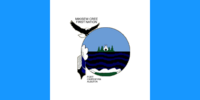Mikisew Cree First Nation facts for kids

Flag of the Mikisew Cree First Nation
|
|
| People | Woodland Cree |
|---|---|
| Treaty | Treaty 8 |
| Headquarters | Fort Chipewyan |
| Province | Alberta |
| Land | |
| Reserve(s) | |
| Land area | 51.161 km2 |
| Population (2019) | |
| On reserve | 172 |
| On other land | 492 |
| Off reserve | 2509 |
| Total population | 3173 |
| Government | |
| Chief | Billy-Joe Tuccaro |
| Tribal Council | |
| Athabasca Tribal Council | |
| Website | |
| mikisewcree.ca | |
The Mikisew Cree First Nation is a group of Indigenous people from the Woodland Cree family. Their name, Mikisew, comes from the Cree word mikisiw (ᒥᑭᓯᐤ), which means "golden eagle." This First Nation lives in northeastern Alberta and the Northwest Territories in Canada.
Many members of the Mikisew Cree First Nation live in towns like Fort McMurray, Edmonton, and Fort Chipewyan in Alberta. Others live in Fort Smith, Northwest Territories.
Contents
What is the Mikisew Cree First Nation?
The Mikisew Cree First Nation is a self-governing group of Indigenous people. They are one of the five Nations that make up the Athabasca Tribal Council. This council helps different First Nations work together on important issues.
Signing Treaties and Agreements
In 1986, the Mikisew Cree First Nation signed a special agreement, called a treaty, with the government of Canada. This treaty helped to set up several reserves for their community. Reserves are lands set aside for the use and benefit of First Nations.
Protecting Their Land and Rights
The Mikisew Cree First Nation has worked hard to protect their traditional lands and rights. In 2005, they won an important case in the Supreme Court of Canada. This case was about their rights to certain areas within Wood Buffalo National Park. This victory showed how important it is for First Nations to have a say in what happens on their ancestral lands.
Changes in Community Membership
Over time, the Mikisew Cree First Nation's community has grown and changed. In the past, some Dene people joined the Mikisew band. This happened because of government policies that affected how Indigenous people could access their traditional hunting and fishing areas, especially near Wood Buffalo National Park. These policies led to many Dene people becoming part of the Mikisew Cree First Nation. Today, many Mikisew Cree members have both Cree and Dene heritage.

